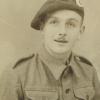I have never managed to find out why I was posted to R.A.F. Cardington, for training as a balloon operator; and when it happened I thought that perhaps it was because somebody higher up did not like me very much.
My training took about four months, and when it was finished I did a short driving course which I passed just as the ballooning season for 1951 began. I then found myself in charge of a balloon team of six equally inexperienced drivers, six vehicles, four trailers and four balloon operators. The value of the vehicles, balloons and stores is just over £10,000 and the C.Q.M .S. ensured that I signed for them on A.F. B108 so that I could be made to pay for any losses or damage which might occur. I was rather worried about this as I had heard that an R.A.F. Sergeant was still paying off debts incurred when his balloon broke away in 1942. Balloons, of course, were much cheaper in those days.
All balloon operations follow much the same pattern. First, the Detachment Commander gets his orders, together with all relative amendments and changes, and, based on these, he prepares his equipment. This is rather a lengthy business since it involves manhandling the 240-lb. concrete blocks and all the heavy kit on to the vehicles, the collection of parachutes from the Irvin Airchute Company and the loading of 120 cylinders of hydrogen on to the trailers. The latter are loaded by cranes which are worked by civilians belonging to 279 Maintenance Unit. They are extremely helpful people and are always to be found at their headquarters in the canteen behind the Air Ministry Gas Works.Once loading is completed, we draw haversack rations or a ration allowance and then, hey, ho ! for the open road.
After about ten miles, the first vehicle generally breaks down. Luckily, we have a R.E.M.E. fitter attached to the party and we usually ensure that he is kept pretty busy. Most of our specialist vehicles went out of production a long time ago. I believe that no winches were made after 1942, and the regularity with which they break down tends to confirm this belief. Naturally, replacement vehicles are out of the question, and the supply of spare parts can only be rectified by the nocturnal visits of the M.T. sergeant to certain stores, dumps or vehicle depots. Breakdowns, refuelling and feeding tend to break the monotony of the long road journeys, some of which take up to two or three days.
On arrival at the D.Z we off-load our kit and start to lay a balloon bed. If the ground is not chalky or full of stones this takes about one hour. The next job is the inflation of the balloon and attachment of the jumping cage, once the balloon has been transferred on to the flying winch. Inflation is never allowed in strong wind conditions or when certain degrees of lightning are present, since gusts of wind can cause some of the large patches to be pulled out of the balloons, and a lightning strike will cause the hydrogen in the balloon to explode. My R.A.F. instructors always impressed on me the necessity of avoiding either of these two contingencies, and so far I have been fairly successful.
Getting the balloon ready for flying takes at least two hours in good weather conditions, and before parachuting starts everything is tested and inspected. Ballooning starts when the T.A. jumpers arrive, and when the exercise is over we either put the balloon on to its bed (if it is to be used the next day) or we deflate it and pack up. The latter job is very difficult in the dark. If the balloon is to be bedded for the night, a picquet of two men is necessary to warn the crew in case the direction of the wind changes and causes the balloon to roll, thereby pulling out some of the patches. At all times, half the strength of the crew must be in the vicinity in order to handle the balloon in emergencies.
At D.Zs. we either live in tents, or are the unwelcome guests of some nearby unit which houses and feeds us. Sometimes we do our own cooking, and on other occasions
we have a special rate of ration allowance and make our own arrangements for feeding. Some of the D.Zs are not very suitable for vehicles, and sometimes winches have had to be helped out by farm tractors and, on one occasion, by an A.F.V., when they have stuck in the mud. If the D.Z. is in a town, we get a visit from most of the school-children, who take the keenest interest in what we do. Their parents watch the proceedings from afar and are usually to be found enjoying a quiet smoke in the area where the hydrogen is kept. There is rarely a dull moment on such occasions.
After a commitment we return to Cardington, dirty and dishevelled to prepare for the next.





Latest Comments
There are currently no comments for this content.
Add Comment
In order to add comments you must be registered with ParaData.
If you are currently a ParaData member please login.
If you are not currently a ParaData member but wish to get involved please register.